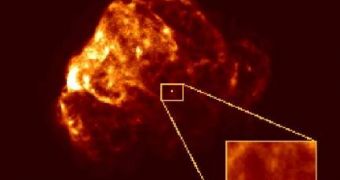Directly assessing the toughness of neutron stars spinning billions of light-years away is a physical impossibility for now, so Indiana University (IU) researcher Charles Horowitz, who is also a College of Arts and Sciences' Department of Physics professor, used supercomputer time at both the university and the Los Alamos National Laboratory, in New Mexico, the United States. Through highly complex computer simulations of what a neutron star would be, at least in theory, made up of, the investigator concluded that the crust that covered them had to be at least ten billion times stronger than steel, or any other metal alloy thus far created on Earth.
Neutron stars are the fast-spinning remains of massive stars that collapsed upon themselves at the end of their life cycle. Although most are only a few dozen miles in diameter, they generate an enormous gravitational pull on nearby objects, while at the same time spinning around their axis at speeds of between 100 and 700 rotations per second. This means that the neutron star is the second most dense formation in the Universe, after black holes. Physicists have estimated that a single teaspoon of their composing matter could weigh as much as 100 million tons back on our planet.
In addition to shedding a large array of particles and radiation while spinning, this class of stars also exhibits another unusual trait for such bodies, namely the fact that their crust has what astronomers infer are mountain-like formations. Understanding how they are formed and why is crucial for furthering a number of astronomical fields of research, including the study of star quakes or magnetar giant flares.
“We modeled a small region of the neutron star crust by following the individual motions of up to 12 million particles. We then calculated how the crust deforms and eventually breaks under the extreme weight of a neutron star mountain,” Horowitz, who conducted the computer simulation with aid provided by the IU Nuclear Theory Center in the Office of the Vice Provost for Research, explained. He added that the smaller molecular simulations were conducted on IU's computers, whereas the full-scale ones were done at LANL's cluster supercomputer, PhysOrg reports.
“The maximum possible size of these mountains depends on the breaking strain of the neutron star crust. The large breaking strain that we find should support mountains on rapidly rotating neutron stars large enough to efficiently radiate gravitational waves,” the expert shared. Astronomers also believe that these mountains can affect the particle and radiation output of neutron stars, and also that they have the ability to generate gravitational waves, which are able to cause ripples in the space-time continuum.
Horowitz concluded by saying that what gave the neutron star crust its extraordinary resilience was primarily the fact that the particles making it up were squeezed together by enormous gravitational forces, coming from the core of the collapsed star. This is the main factor that allows it to sustain the large and dense mountains that are formed on top of it.

 14 DAY TRIAL //
14 DAY TRIAL //